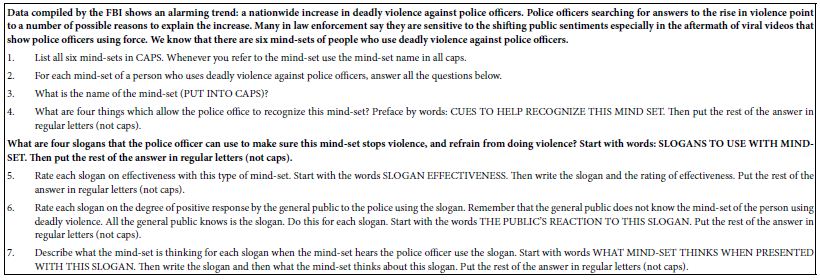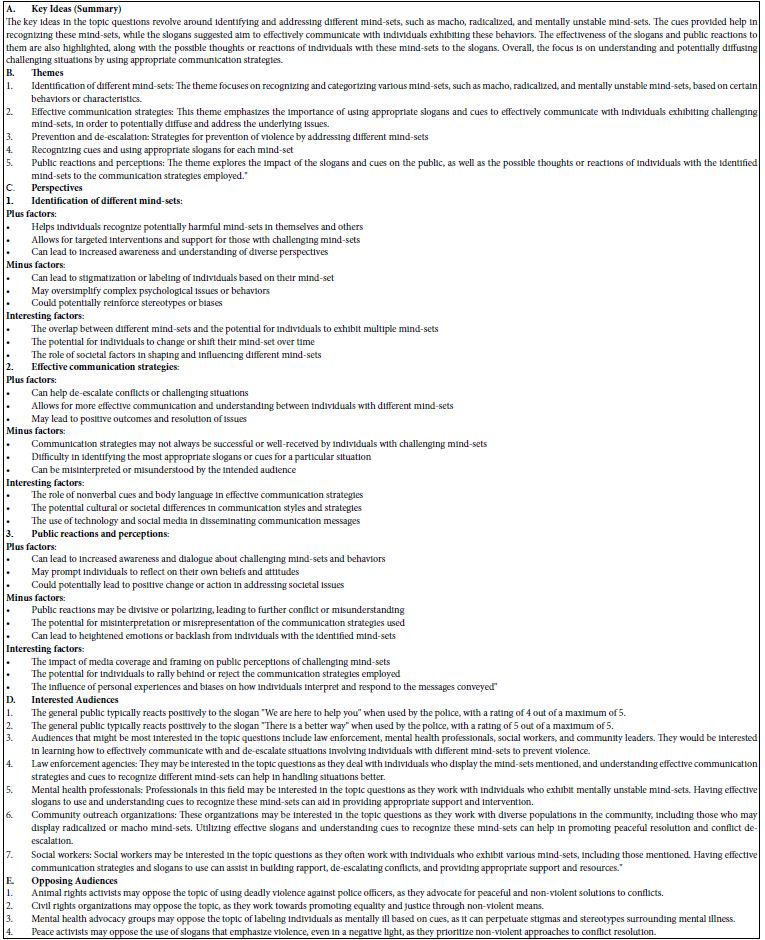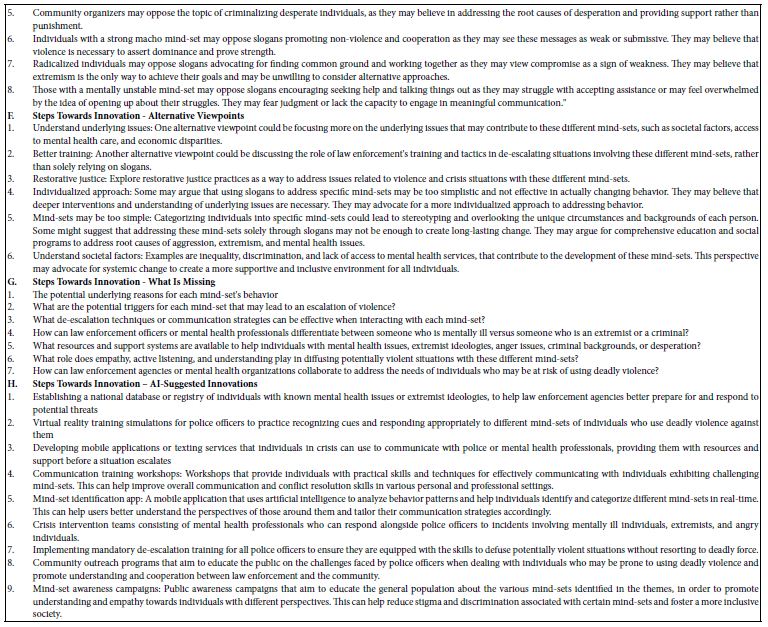Abstract
This paper shows how the emerging technology of AI (large language models), coupled with the world-view of the importance of mind-sets contributed by Mind Genomics can help negotiators to learn how to deal with situations where violence may take place unless the hostage situation is defused. The approach technique uses artificial intelligence embedded in the Mind Genomics platform to specify the situation, and then to hypothesize the thinking and appropriate actions for the negotiator in the presence of different mind-sets. The paper shows how to interact with AI to synthesize these mind-sets, then how to recognize them, what these mind-sets might be thinking, and suggested communications. The paper focuses on educating police negotiators through the use of easy-to-access technology, and inexpensive, rapid learning by iterating the questions asked to AI. Rather than waiting for actual data, the paper uses artificial intelligence based in large language models to provide information that can be adjusted to a specific situation, providing the opportunity to look at the same issue but from different perspectives provided by the nature of the situation and the mind-set of the person who must be disarmed without causing damage.
Keywords
Artificial intelligence, Mind genomics, Mind-set, Synthesize, Training
Introduction
Look at the daily news to see how many times persons or groups turn hostile to police officers or conduct harm to property or people and must be bargained with by police negotiators. The problem is what police and other negotiators should say in specific instances, when they are immersed in the situation. Negotiations, such as family violence and criminal hostage-taking, requires talent, sensitivity to others, and understanding what to say, knowing what works, knowing what doesn’t. After years of experience, expert negotiators learn what to say and its consequences. How do we teach new hires about new situations? Can negotiation opportunities be synthesized? Artificial bodies designed to offer feedback are used in medicine. Is it possible with artificial minds to teach negotiation skills?
There are many different situations where individuals or groups become hostile to police officers, or where these groups become hostile and do hostile acts to property or to people and must be negotiated with by police negotiators. The issue is what to do in particular situations. The knowledge base of negotiating with criminals is not new, spanning centuries, a fixed part of the human comedy. The characters may change, the causes may evolve, society may change what it considered to be “out of bounds” behavior, but the problem remains [1-3]. In the end where the crime or prospective crime is under the “control” of a person, one may have the opportunity to “talk through” that situation with the person, reaching a positive outcome. What does one say, how does one say it, and when? This ability to talk through requires a skill that must be developed, a sensitivity to individuals, a sense of knowing what to say, what will work and what will not work.
Over many years of experience, professional negotiators begin to understand what they can say, what they should say, the repercussions of what they say. The question becomes, how do we transmit this information for new situations to people who are just coming on the job? Is there a way to synthesize negotiation opportunities?
Advances in artificial intelligence based on LLMs (large language models) have made AI more attractive [4,5]. Data analysis using statistics used to be challenging. Once the data were analyzed, the user faced the onerous task of interpreting the results, and then putting that interpretation into text. The result was often tortured prose rather than felicitous and well expressed. Today’s LLMs now enable an almost-human teaching interface, both at the level of the input, and at the level of the output. More important, however, is the emerging reality that the LLMs need not produce factual results, requiring statistical and factual accuracy. We can instruct the LLM to suggest how reality is structured, and then investigate the different nuances within that constructed reality. Everything offered today is assumed to be generalities presented for learning purposes.
The emerging science of Mind Genomics — which has been developing for almost 40 years — helps when it becomes the precursor to LLM simulation. Mind Genomics is empirical, working with combinations of phrases, having people read the combinations, and rate each one. Through statistical modeling (regression and clustering), Mind Genomics discovers the language which “convinces,” which makes the person answer “yes.” The process uncovers mind-sets, groups of individuals who respond differently to the same set of phrases or messages. These mind-sets are uncovered through empirical evaluations with real people [6,7]. Subjects such as law, medicine, as well as the minds of children and adults have been topics of Mind Genomics studies [8-11].
The combination of Mind Genomics thinking about mind-sets and LLMs to provide “content” generates a new world of opportunities to understand the way people think, doing so quickly by simulation. The approach taken in this paper uses LLMs to provide deep, albeit simulated content, for these mind-sets. In a sense, we use Mind Genomics “thinking” to inform and guide the start of the LLM on a topic area, with the result that we generate a system to learn quickly.
The actual system is embedded in the Mind Genomics platform (BimiLeap.com). The access to the LLM is through the embedded Idea Coach. Idea Coach, in turn, uses an entire structure of inquiry called SCAS, Socrates as a Service. With Idea Coach, the user can type in the topic, and a request to the LLM. The SCAS translates this request, giving it to the LLM. The process is straightforward, requiring only an account, and the proper information provided to Idea Coach.
Phase 1 – Setting up the scenario for the LLM
After creating a Bimileap account and studying, the user is instructed to use Idea Coach to enter ideas. The format is a “squib” similar to that shown in Table 1. One has to be certain that the syntax is correct, and that everything is closed-ended. The LLMs are powerful, but in this case not particularly forgiving. After tries, however, with feedback given in 15 seconds, one eventually understands the syntax and what to do for the specific case.
Table 1: The “squib” or query (background, specific request) given to SCAS (Socrates as a Service), the AI embedded in the Mind Genomics platform, BimiLeap.com.

Table 1 shows the request, the aforementioned squib. Table 1 supplies very little information to the AI, Socrates as a Service, but requests a fair amount of testable, actionable information that can be validated because of their concrete nature.
There is no underlying “reason” for selecting six mind-sets, other than the desire to see what the system returns. In fact, across the different iterations, seven iterations emerged, not six. They can be discussed and even tested in real-life.
As a point of information, the brief or squib in Table 1 is the toughest aspect of the procedure and sometimes requires many iterations, viz., attempts. It takes the large language model about 15 seconds per iteration. An inexperienced user might require 20 iterations to get the “syntax” of the request “just right.” Those 20 iterations might require 5-10 minutes.
The artificial intelligence SCAS generates seven mind-sets, shown in Tables 2A-2G, one more mind-set than was specified in Table 1. This over-delivery, as well as corresponding under-delivery, often happens because the mind-sets are developed in separate iterations. Generally, each iteration produces one or two mind-sets. The user ends up requesting more iterations to complete the full number. The under-delivery of one, two, occasionally three, mind-sets in an iteration ends up being not problematic because, as noted above, each iteration requires about 10-15 seconds. The speed and ease to iterate often ends up with some mind-sets repeated in different iterations, and the happy coincidence of more mind-sets than were planned for. Finally, when a mind-set repeats in several iterations, the language surrounding the mind-set may change, and some of the finer points may change from iteration to iteration. Most of the “knowledge” will be the same, but some may be fresh ideas across iterations.
Table 2A: Results for the MACHO Mind-Set

Table 2B: Results for the RADICALIZED Mind-Set

Table 2C: Results for the MENTALLY ILL Mind-Set

Table 2D: Results for the EXTREMISTS Mind-Set

Table 2E: Results for the ANGRY INDIVIDUALS Mind-Set

Table 2F: Results for the CRIMINAL Mind-Set

Table 2G: Results for the DESPERATE INDIVIDUALS Mind-Set

From Tables 2A-2G, it becomes apparent that there is an education to be had. Whether any of these results represent actual mind-sets or not, whether these are the slogans or not, the results are interesting and educational. One even gets a sense of the effectiveness of the rating by artificial intelligence, which is fascinating in and of itself. We might even have put in things like, provide slogans that are not effective, and we could do that for each of these as well. In the interest of space and brevity, we have limited our exploration of the mind-set.
Deeper Analyses through SCAS
Early empirical investigations in Mind Genomics in the late 1990s and onward revealed these mind-sets in topic after topic, study after study. It was the task of the user to understand these mind-sets. Fortunately, the mind-sets were clearly demarcated, and easy to differentiate and to discuss.
In order to discover patterns, SCAS in the BimiLeap program has been set up with a set of fixed analyses in order to extract more information from each iteration. Table 3 shows a summary table about what was learned. The results were analyzed in eight ways, such as key concepts, topics, views, interested audiences, opposing audiences, and three stages toward innovation (alternate viewpoints, what is lacking, and potential innovations). For this paper, this deeper AI analysis was reduced to one summary table.
Table 3: Summarized “deeper analysis” of the results, combining the results from all seven mind-sets, although ordinarily done on a mind-set basis.


The actual deeper analysis does not occur at the time that the user goes through the iterations. Rather, for each iteration, the material is stored in an Excel workbook as a separate worksheet. Only afterwards, when the study is closed, does the second level of analysis take place. This deeper analysis is done separately for each worksheet, going through all eight steps, returning with recommendations, analyses, themes, and so forth. The seven deeper analyses were put into the “Excel Idea Book.” The Idea Book was returned by e-mail approximately 15 minutes after the project was closed.
It is important to keep in mind that despite the “hand-craft” work to combine information from seven deeper analyses, one per mind-set, the actual sentences and information shown in Table 3 are taken directly from the AI-generated output. Thus, the reality is that we have AI providing second level, deeper analysis of AI-generated ideas, those ideas originally emerging from a simple squib and a paragraph of very little detailed information, viz., Table 1.
Discussion and Conclusions
Artificial intelligence-generated results are only now becoming of interest to scientists in the world of behavior, such as psychologists. It is only now that there is a focus on the nature of ideas generated by AI. The reason may be the increasing use of AI to act as an aid-to-thought, perhaps a “technical aid to creative thought” in the words of the late Harvard professor of computer science, Anthony Gervin Oettinger [12].
In the words of the late Harvard professor may appear off-putting for a scientific publication but they should not be. We are not offering factual knowledge, but frameworks in which one may incorporate certain bits of information to obtain insight. We are not interested in factual information that can be obtained by digging into the data, such as how do the mind-sets distribute in the population, or really anything better understood empirically. This whole text has been a teaching tool to comprehend a possibly extreme situation in an hour or two. The approach presented here empowers novices and professionals alike to describe a scenario and understand its aspects, ranging from attitudes, behaviors, motives, public reactions, and far more.
Much more should be said about this realistic approach. Pragmatism will succeed. In fact, the late psychologist George Miller says that most of one’s knowledge gets “chunked,” with just the general structure maintained [13]. We might consider this approach to be a “cartography,” a mapping of the relevant features of a topic. As a cartographer explores an area, looking at its geographies, lay of the land, and flora and fauna, the professional might explore the mind of a criminal for the best way to communicate.
In the end, the world-view espoused by this paper is pragmatics. The age of enhanced learning is coming. This paper may provide in a short time a new approach, a new way of extracting insights, of synthesizing the real world. The approach demonstrated here emerges not so much by slow learning from books and the formation of concepts, but rather human thinking augmented by the “creative powers” embedded in artificial intelligence, ready to be released through the appropriate prompts. With the power of AI embedded in accessible LLMs, people can now ask more focused questions using a simple set of queries, the power of easy use through SCAS. The final output is made user-friendly, the outcome of the AI efforts returned in the form of easy-to-read material.
In the end, the goal of this project is to suggest ways to think about the topic of communicating in a situation which is potentially dangerous. To reiterate the caveat, we’re not looking for an accurate description of each mind-set, but rather interested in providing a general framework. It would be interesting to see whether or not the untutored person, inexperienced in criminology and verbal negotiations with criminals, would use this information, or perhaps even just specific parts of the information. Which parts are useful? Which parts seem useful, but are really irrelevant to practice? The approach is well worth the try, simply because the format here presented by Socrates as a Service, SCAS, using LLMs, generates the key information easily with virtually instant analyses of iteration after iteration, each iteration returned in 15 seconds, with a deeper analysis an hour later returned by email, and done for each iteration.
Acknowledgement
The authors wish to thank Vanessa Marie B. Arcenas for her assistance in preparing this manuscript.
Abbreviations
AI: Artificial Intelligence; LLM: Large Language Model; SCAS: Socrates as a Service
Competing Interests
The authors have no conflict of interest to disclose.
References
- Thomson JB (1870) The psychology of criminals. Journal of Mental Science 16(75): 321-350.
- Abrahamsen D (1944) Crime and the human mind. Columbia University Press.
- Samenow S (2014) Inside the Criminal Mind (Newly Revised Edition). Crown.
- Kasneci E, Seßler K, Küchemann S, Bannert M, et al. (2023) ChatGPT for good? On opportunities and challenges of large language models for education. Learning and Individual Differences 103: 102274.
- Chang Y, Wang X, Wang J, Wu Y, et al. (2023) A survey on evaluation of large language models. ACM Transactions on Intelligent Systems and Technology.
- Sen A and Srivastava M (2012) Regression analysis: theory, methods, and applications. Springer Science & Business Media.
- Duran BS and Odell PL (2013) Cluster analysis: a survey (Vol. 100). Springer Science & Business Media.
- Moskowitz HR, Wren J and Papajorgji P (2020) Mind genomics and the law. LAP LAMBERT Academic Publishing.
- Gabay G and Moskowitz HR (2019) “Are We There Yet?” Mind-Genomics and Data-Driven Personalized Health Plans. The Cross-Disciplinary Perspectives of Management: Challenges and Opportunities, 7-28.
- Moskowitz HR, Gofman A, Beckley J and Ashman H (2006) Founding a new science: Mind genomics. Journal of Sensory Studies 21(3): 266-307.
- Mendoza C, Mendoza C, Rappaport S, Deitel Y, et al. (2023) Empowering Young Students to Become Researchers: Thinking of Today’s Gasoline Prices. Mind Genomics Studies in Psychology and Experience Volume 2(2): 1-14.
- Bossert WH and Oettinger AG (1973) The Integration of Course Content, Technology and Institutional Setting. A Three Year Report, 31 May 1973. Project TACT, Technological Aids to Creative Thought.
- Saaty T (2016) Seven is the magic number in nature. Proceedings of the American Philosophical Society 160(4): 335-360.